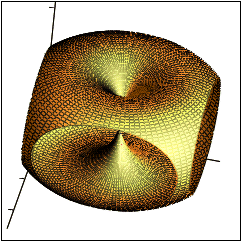 To expand our thinking from scalar quantities to the quantities described by vectors and matricies, we must also expand our notion of function.
To expand our thinking from scalar quantities to the quantities described by vectors and matricies, we must also expand our notion of function.
 To expand our thinking from scalar quantities to the quantities described by vectors and matricies, we must also expand our notion of function.
To expand our thinking from scalar quantities to the quantities described by vectors and matricies, we must also expand our notion of function.
The general idea is always the same: A function is a rule which describes how to uniquely determine an output from an input. However, we must consider what it means for a function to have inputs and outputs that are vectors or matricies.
We've noted that functions of the form
What about:
Obviously, there are a lot of possibilities. All of the possibilities occur frequently in applications.
|
Vector functions of a scalar variable are often called parametric curves. The tip of the vector |

|
|
Scalar functions of a vector variable are studied in advanced calculus. Their plots are surfaces rather than curves. To picture these functions, we need to move beyond the 2D x-y plots with which we have become familiar in precalculus. Functions of the form |

|
|
Vector functions of a vector variable were mentioned earlier in the discussion of river currents. These vector fields assign a vector – a number and a direction – to every point in the xy-plane or in xyz-space. Vector fields model phenomena as diverse as atmospheric currents, complex motions of the economy, and electromagnetic fields. |

|
|
|
|
|
| Back to Contents | ||